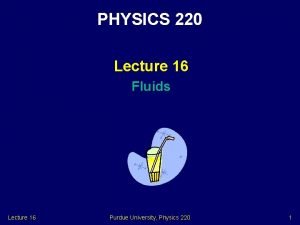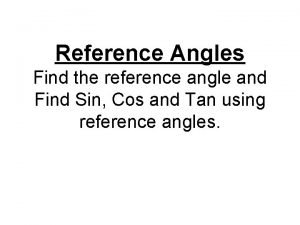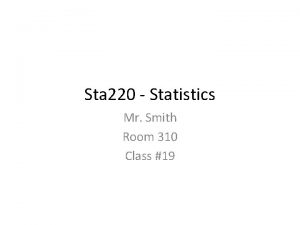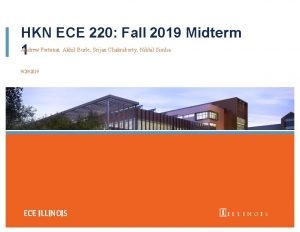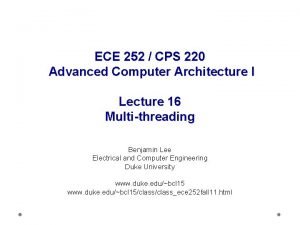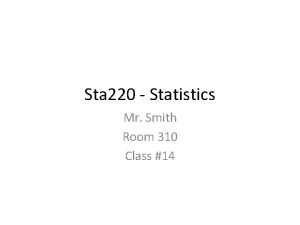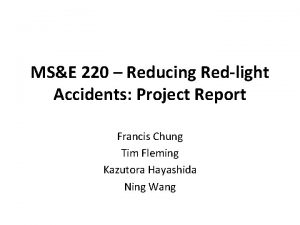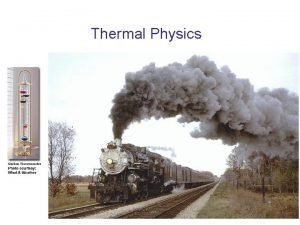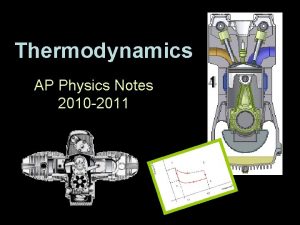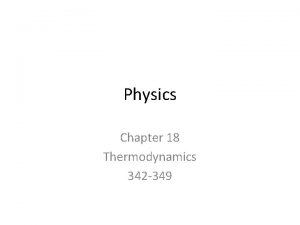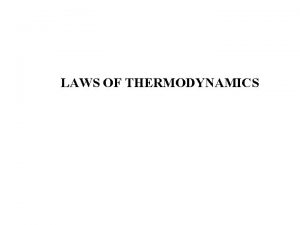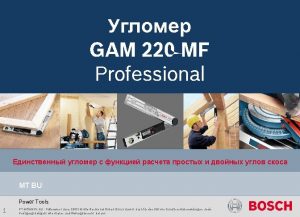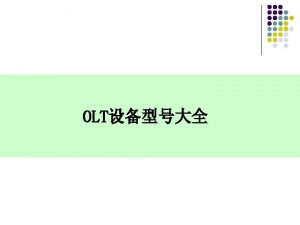Physics 220 Lecture 27 Thermodynamics II Lecture 27




















- Slides: 20

Physics 220 Lecture 27 Thermodynamics II Lecture 27 Purdue University, Physics 220 1

Overview – First Law of thermodynamics: Energy Conservation • Q = U + W – Heat Engines • Efficiency = 1 -QC/QH – Refrigerators • Coefficient of Performance = QC/(QH – QC) • Today – – Lecture 27 Second law of thermodynamics Carnot Engine (Sadi Carnot 1796 -1832) Entropy Disorder Purdue University, Physics 220 2

Second law of thermodynamics • Heat flow spontaneously from a warm object to a colder one. It is not possible for heat to flow spontaneously from a cold object to a warmer one. Lecture 27 Purdue University, Physics 220 3

The world’s best engine? Lecture 27 Purdue University, Physics 220 4

Heat Engine: Efficiency The objective: turn heat from hot reservoir into work HEAT ENGINE TH The cost: “waste heat” QH 1 st Law: QH -QC = W Efficiency e W/QH = (QH-QC)/QH = 1 -QC/QH Lecture 26 Purdue University, Physics 220 W QC TC 5

Engines and Refrigerators HEAT ENGINE REFRIGERATOR TH TH QH System QH W QC TC TC System taken in closed cycle Usystem = 0 l Therefore, net heat absorbed = work done QH - QC = W (engine) QC - QH = -W (refrigerator) energy into blob = energy leaving blob l Lecture 26 Purdue University, Physics 220 6

Refrigerator: Coefficient of Performance REFRIGERATOR The objective: remove heat from cold reservoir The cost: work TH QH 1 st Law: QH = W + QC Coefficient of performance Kr QC/W W QC TC = QC/W = QC/(QH - QC) Lecture 26 Purdue University, Physics 220 7

i. Clicker • An ideal heat engine absorbs 36 k. J of heat and exhausts 18 k. J of heat every cycle. What is the efficiency of the engine? A. 1 B. 0. 5 C. 2 D. 0. 25 QH -QC = W Efficiency e W/QH Lecture 26 Purdue University, Physics 220 8

Carnot Cycle • Idealized Heat Engine – No Friction – Reversible Process • • Isothermal Expansion Adiabatic Expansion Isothermal Compression Adiabatic Compression • QH all at TH • QC all at TC • This is most efficient engine Lecture 27 Purdue University, Physics 220 9

Ideal Efficiency For a Carnot engine QH TH and QC TC e = 1 -QC/QH = 1 - TC/TH Carnot engine most efficient since it operates across greatest T difference for given TH and TC Kr QC/W For refrigerator: = QC/W Lecture 27 = QC/(QH - QC) = TC/(TH - TC) Purdue University, Physics 220 10

Engine Lecture 27 Purdue University, Physics 220 11

Real Engines For ideal Carnot engine i. e. Greatest possible efficiency e = 1 -QC/QH = 1 - TC/TH and QH /TH = QC /TC All operating engines are less efficient and QH /TH < QC /TC Define Entropy S = Q/T SC > SH Then S out of hot reservoir is less than S into cold reservoir. Lecture 27 Purdue University, Physics 220 12

Q AT LOW T BRINGS ABOUT MORE DISORDER THAN IT CAUSED AT HIGH T Lecture 27 Purdue University, Physics 220 13

Entropy and Disorder In thermal conductivity the same heat T flows from hot to cold H Hot QH = Q C = Q TC Cold SC = Q/TC > SH = Q/TH MORE S ADDED TO COLD THAN TAKEN FROM HOT TOTAL S INCREASE Q AT LOW T BRINGS ABOUT MORE DISORDER THAN IT CAUSED AT HIGH T Lecture 27 Purdue University, Physics 220 14

New Concept: Entropy (S) • A measure of “disorder” • A property of a system (just like P, V, T, U) – related to number of different “states” of system • Examples of increasing entropy: – ice cube melts – gases expand into vacuum • Change in entropy: S = Q/T • >0 if heat flows into system (Q>0) • <0 if heat flows out of system (Q<0) Lecture 27 Purdue University, Physics 220 15

Entropy Question Some ice (-5 C) is used to cool a cup of water S = Q/T What happens to the entropy of the ice? A) Increase B) Same C) Decreases Heat enters ice: Q>0 What happens to the entropy of the water? A) Increase B) Same C) Decreases Heat Leaves water: Q<0 What happens to the total entropy (water+ice)? A) Increase B) Same C) Decreases Lecture 27 S = Q/Tice – Q/Twater Purdue University, Physics 220 16

Second Law of Thermodynamics • The entropy change (Q/T) of the system+ environment 0 – never < 0 – order to disorder • Consequences – A “disordered” state cannot spontaneously transform into an “ordered” state – No engine operating between two reservoirs can be more efficient than one that produces 0 change in entropy. This is called a Carnot engine Lecture 27 Purdue University, Physics 220 17

Engines and the 2 nd Law The objective: turn heat from hot reservoir into work HEAT ENGINE The cost: “waste heat” 1 st Law: QH -QC = W Efficiency e W/QH = 1 -QC/QH S = QC/TC - QH/TH 0 Therefore, QC/QH TC/ TH S = 0 for Carnot QC/QH = TC/ TH for Carnot Therefore e = 1 - QC/QH 1 - TC/ TH e = 1 - TC/ TH for Carnot e = 1 is forbidden! e largest if TC << TH Lecture 27 Purdue University, Physics 220 TH QH W QC TC 18

i. Clicker Consider a hypothetical device that takes 1000 J of heat from a hot reservoir at 300 K, ejects 200 J of heat to a cold reservoir at 100 K, and produces 800 J of work. Does this device violate the second law of thermodynamics ? correct A) Yes B) No SH = QH/TH = (-1000 J) / (300 K) = -3. 33 J/K SC = +QC/TC = (+200 J) / (100 K) = +2 J/K STOTAL = SH + SC = -1. 33 J/K (violates 2 nd law) W (800) = Qhot (1000) - Qcold (200) l Efficiency = W/Qhot = 800/1000 = 80% l Max eff = 1 -Tc/Th =1 - 100/300 = 67% l Lecture 27 Purdue University, Physics 220 19

Summary of Concepts • First Law of thermodynamics: Energy Conservation Q = U + W • Heat Engines Efficiency = 1 -QC/QH • Refrigerators Coefficient of Performance = QC/(QH - QC) • Entropy S = Q/T • 2 nd Law: Entropy always increases! • Carnot Cycle: Reversible, Maximum Efficiency e = 1 – Tc/Th Lecture 27 Purdue University, Physics 220 20
 Physics 220 purdue
Physics 220 purdue 01:640:244 lecture notes - lecture 15: plat, idah, farad
01:640:244 lecture notes - lecture 15: plat, idah, farad Physics 101 lecture
Physics 101 lecture Atmospheric physics lecture notes
Atmospheric physics lecture notes Phy101 lecture 1
Phy101 lecture 1 Physics 101 lecture notes pdf
Physics 101 lecture notes pdf Physics 111 lecture notes
Physics 111 lecture notes Wave notes pdf
Wave notes pdf Ia physics examples
Ia physics examples Modern physics vs classical physics
Modern physics vs classical physics University physics with modern physics fifteenth edition
University physics with modern physics fifteenth edition Refernce angle
Refernce angle Sta 220
Sta 220 Dl 220 2006
Dl 220 2006 Mhr=220-16
Mhr=220-16 Smtp 220
Smtp 220 Ece 220 uiuc
Ece 220 uiuc Ece252
Ece252 Sta 220
Sta 220 Cec 220
Cec 220 Kazutora hayashida
Kazutora hayashida
